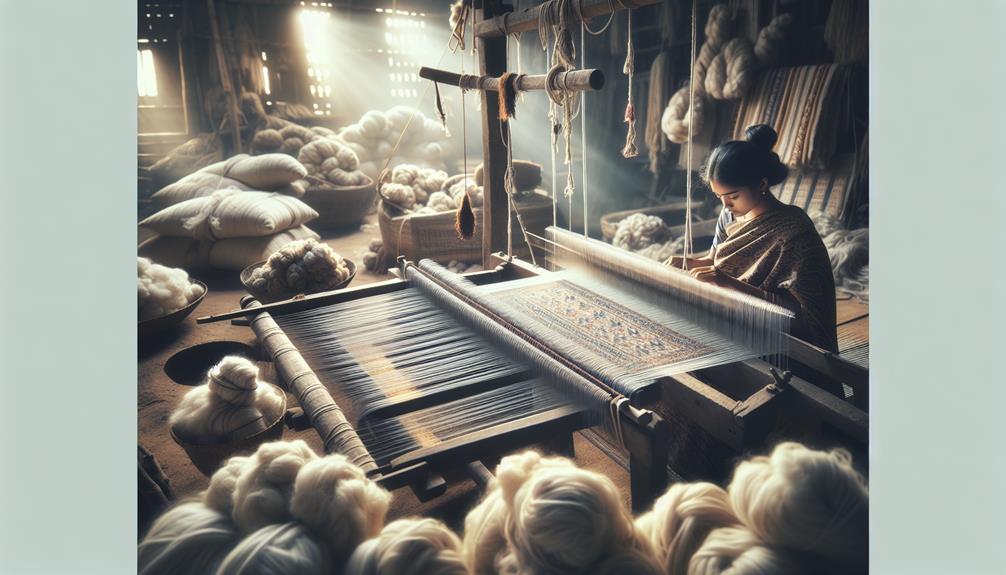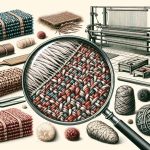Have you ever wondered why tweed is so darn expensive? Well, it's not just any ordinary fabric; it's steeped in tradition and craftsmanship. The process of making tweed involves meticulous hand-weaving techniques, often in less accessible regions, which limits how much can be produced. Plus, the wool used is usually of a very high quality and often scarce. These factors alone set the stage for a higher price tag. But there's more to the story that makes tweed a luxury item. Interested in what gives tweed its prestigious status and why it might actually be worth the splurge? Let's unravel this thread together.
Table of Contents
Key Takeaways
- Tweed is handwoven by skilled artisans, making its production labor-intensive and time-consuming.
- High-quality wool from specific sheep breeds is used, ensuring durability but increasing costs.
- The meticulous dyeing, drying, and weaving processes require precision and contribute to the fabric's uniqueness and high price.
- Limited supply of raw materials and small-scale production restrict availability, boosting exclusivity and demand.
- The craftsmanship involved preserves cultural heritage and traditional methods, adding to the fabric's value and prestige.
Origins of Tweed Fabric
Tweed's origins trace back to the remote Scottish islands, where local artisans first crafted this durable fabric. Let's explore its historical significance and fashion evolution.
Initially, tweed was a pragmatic choice for islanders. Its thick, water-resistant properties made it ideal for protection against harsh climates. But it wasn't just about staying warm. The fabric's unique patterns, woven from locally dyed wool, carried symbols and colors that identified different family clans. This added a layer of cultural identity to the fabric, embedding deep historical roots in its threads.
As tweed's reputation for durability and quality grew, it caught the attention of the British aristocracy in the 19th century. It became a staple for outdoor sports attire, marking its evolution from a practical fabric to a symbol of upper-class leisure. Fashion icons and designers soon took notice, and by the 20th century, tweed had been transformed. It was no longer just for the countryside; it had become a fixture in high fashion, adorning runways and tailored into chic, modern designs.
Understanding tweed's origins helps us appreciate not just the fabric but the tradition and craftsmanship behind it, which continue to impact its value and prestige today.
Unique Wool Sources
One key reason tweed remains costly is its reliance on specific, high-quality wool sources. Tweed's unique texture and durability stem from the wool of particular sheep breeds, each chosen for their distinct fiber characteristics. For instance, the wool from Cheviot or Shetland sheep is commonly used; these breeds provide the robust yet soft fibers necessary for high-quality tweed.
The wool undergoes specific fiber treatments before it becomes the tweed fabric we're familiar with. This includes processes such as carding and combing, which align the fibers to make them smoother and more uniform. This not only enhances the feel of the fabric but also its appearance. The dyeing process too is meticulous, ensuring the rich colors that are characteristic of tweed. After dyeing, the wool fibers are spun into yarn, which maintains the integrity and natural resilience of the original fibers.
These steps, dictated by the quality of the raw material and the care in processing, justify the price tag on tweed garments. It's not just fabric you're paying for; it's a culmination of selective breeding, specialized handling, and a heritage of craftsmanship. Each piece is a reflection of the intricate journey from sheep to shop.
Labor-Intensive Manufacturing
Additionally, the manufacturing of tweed is remarkably labor-intensive. This isn't just about the weaving itself; there's a whole process before the fabric even hits the loom. Here's a breakdown:
- Raw Material Preparation: Every batch of wool must be sorted, cleaned, and sometimes blended with other fibers. This is a meticulous task that requires skilled hands. There's minimal automation potential here due to the delicate nature of the fibers.
- Dyeing and Drying: Unlike synthetic fabrics, the dyeing process for tweed must be carefully controlled to preserve the integrity of the wool. After dyeing, the wool must be air-dried to prevent shrinkage and maintain quality, which is a slow process.
- Setting up the Loom: This is vital and must be done with precision. Each pattern of tweed has its unique set-up, requiring manual adjustment and alignment by experienced technicians to safeguard the quality of the weave.
The cost analysis of these steps shows that the time and expertise required significantly contribute to tweed's high price. Reducing steps or rushing through them isn't an option if maintaining quality is a priority. Hence, while labor costs are high, cutting corners would drastically lower the desirability and value of the final product.
Artisanal Weaving Techniques
Moving beyond the initial steps, the true art of tweed shines in its artisanal weaving techniques. As I delve into these methods, you'll see how deeply the crafters' choices impact the final product. The techniques aren't just about forming fabric but about creating a narrative through color variations and pattern diversity, which are central to tweed's appeal.
Artisanal weavers use traditional looms, which allow for a level of customization that modern machines can't match. I've noticed that the weaver's personal touch and the specific mix of threads lead to unique color shades and intricate patterns. This isn't something that can be fully automated. Each batch of tweed can vary slightly depending on the wool's natural color and the weaver's technique at that moment.
Moreover, the pattern diversity in tweed is astounding. From the classic herringbone and check to more modern, experimental designs, each pattern requires a different set of skills and time to set up on the loom. It's this diversity that often leads to one-of-a-kind pieces, highly sought after in the fashion world.
Understanding these artisanal aspects, you start to appreciate why tweed remains not just a fabric, but a craft deeply embedded with skill and creativity.
Geographic Production Constraints
When you look at why tweed is so pricey, you can't ignore where it's made.
Only a few places in the world have the right conditions and resources to produce authentic tweed.
This scarcity of suitable locations adds a lot to the cost.
Limited Production Regions
One major reason for tweed's high cost is that it's produced in only a few regions worldwide, which limits its availability. Let me break down a few factors contributing to this geographic exclusivity:
- Climate Impact: Tweed requires specific climatic conditions for the wool to have the desired quality. Only certain regions offer this perfect storm of weather.
- Regulatory Challenges: Areas known for tweed have strict regulations protecting their traditional crafts, which restricts new manufacturers from setting up shop, keeping production volumes low.
- Historical Significance: Regions like Scotland, particularly the Outer Hebrides, are steeped in the history of tweed. This heritage limits production to those areas to maintain authenticity, further restraining supply.
Natural Resource Scarcity
In addition to limited production areas, the scarcity of natural resources essential for making high-quality tweed also drives up its price. The wool needed must come from specific breeds of sheep, often found only in certain regions. These areas face their own challenges, such as harsh climates and limited grazing land, which can affect the wool's availability and quality.
Effective resource management is vital here. If we overuse these areas or don't consider the environmental impact, the wool's quality could decline, further limiting supply. This careful balancing act guarantees the sustainability of tweed production but also contributes to its high cost. Managing these resources wisely isn't just about economics; it's about preserving a tradition and minimizing our ecological footprint.
Quality and Durability
When we talk about why tweed is so pricey, we can't ignore its quality and durability. Tweed uses high-quality materials that guarantee it lasts for ages.
The detailed craftsmanship involved in making each piece adds to this durability. Plus, the fabric's ability to withstand wear and tear makes it a smart buy that stands the test of time.
Timeless Material Selection
Tweed's reputation for quality and durability stems from its selection of timeless materials. Unlike modern synthetics, which can fade or wear rapidly, tweed uses natural fibers known for their longevity and resilience. Here's why this material remains excellent:
- Natural Wool: The primary component of tweed, wool, is incredibly durable, insulating, and water-resistant.
- Blending Techniques: By skillfully blending wool from different types of sheep, tweed achieves a unique balance of softness and strength.
- Resistant to Trends: Tweed colors often reflect the natural landscape, making them immune to fleeting color trends seen in other fashion materials.
This approach ensures that tweed not only lasts for decades but also remains stylishly relevant throughout.
Craftsmanship and Techniques
The craftsmanship behind tweed is as intricate as it's enduring, highlighting skilled techniques that contribute to its high cost and durability. Weavers blend time-honored skills with modern material innovation, ensuring each fabric not only lasts but also respects environmental impact.
This meticulous process involves controlling the texture and strength meticulously, often adjusting looms with a precision that comes from years of experience. It's not just about weaving; it's about creating a legacy of quality.
Furthermore, the push towards sustainable practices means selecting eco-friendly dyes and fibers that reduce the fabric's environmental footprint. Each piece of tweed is a tribute to the dedication of its craftsmen, marrying tradition with contemporary concerns for a smarter, more durable textile.
Long-lasting Wear Benefits
One major perk of investing in tweed is its remarkable durability that withstands the test of time. When I buy tweed, I'm not just getting a piece of clothing; I'm making a long-term addition to my wardrobe. The strength of the fibers and tight weave contribute to a garment that really holds up, whether I'm wearing it to a formal event or while wandering the countryside.
Here's why tweed's durability is a smart choice:
- Resilience: Tweed fibers are naturally tough, resisting wear and tear.
- Versatility: It effortlessly adapts from casual to formal settings.
- Comfort factor: Despite its sturdiness, tweed remains breathable and comfortable, adapting to various weather conditions.
Limited Production Runs
Exploring production runs greatly increase tweed's price tag. When we explore the world of tweed, we're not discussing mass-produced fabric. The batch sizes are smaller, which means that each piece of tweed is almost like a limited edition item. This isn't your run-of-the-mill production line; it's a meticulous, crafted process that doesn't exactly lend itself to scaling up.
Smaller batches mean less scalability. This isn't just about being unable to meet potentially higher demand quickly; it's also about the economic model. Larger batch sizes typically reduce the cost per unit due to economies of scale—basically, producing more at once usually cuts down costs. But with tweed, the focus remains on quality over quantity, which inherently limits production scalability and keeps the supply tight.
This scarcity of production not only ups the desirability but also the price. Each batch of tweed can vary slightly, adding to its unique charm but also complicating the production process. The result? A higher price tag, justified by the exclusivity and meticulous craftsmanship involved. So, when you buy a piece of tweed, you're not just buying fabric; you're investing in a piece of artful manufacture that can't be easily replicated.
Cultural Heritage Value
Celebrating its deep roots, tweed's cultural heritage greatly enhances its value and appeal. The fabric isn't just a textile; it's a narrative woven through time, embodying tradition and craftsmanship. As I explore why tweed holds such a prestigious spot in the fashion world, it's clear that its historical significance plays a huge role.
Here's how tweed's cultural heritage adds to its allure:
- Historical Significance: Originating from Scotland and Ireland, tweed began as a practical solution for harsh, cold weather. Over centuries, it became associated with the aristocracy and outdoor sports, embedding itself in elite culture.
- Symbol of Identity: For many, wearing tweed is a nod to cultural identity, especially within Celtic communities. It represents a blend of heritage and pride, making it more than just a piece of clothing.
- Influence on Fashion Trends: Tweed continuously influences modern fashion. Designers often draw on its rich history to create modern reinterpretations that resonate with current trends, ensuring that tweed remains relevant and desirable.
Understanding tweed's cultural heritage isn't just about looking back; it's about recognizing how this heritage is continually redefined and adapted in the fabric of modern fashion.
Customization and Personalization
When you're looking at tweed, one big reason it's pricy is the option for customization. You can get a tailored fit that hugs your figure just right, or choose unique designs that stand out from the crowd.
This level of personalization means each piece can be as individual as the person wearing it.
Tailored Fit Options
Customization and personalization options in tweed clothing allow you to achieve a tailored fit that perfectly suits your style and body shape. By focusing on measurement precision, these options guarantee that each piece not only fits but also complements the latest style trends.
Here's how you can personalize your tweed:
- Choose Your Cut – Whether it's a slim fit blazer or a relaxed tweed coat, pick a style that flatters your physique and aligns with your personal aesthetic.
- Select the Fabric Weight – Opt for lighter weaves for spring or thicker, durable tweeds for the colder months.
- Detailing – Decide on the type of buttons, pockets, and lapels that showcase your unique style preferences.
This level of customization elevates the value of tweed, making it worth the investment.
Unique Design Choices
Building on the tailored fit, let's explore how unique design choices further personalize tweed garments to reflect individual style. Tweed's charm isn't just in its durability; it's in the myriad color variations and pattern diversity that offer endless customization options.
I can choose from classic herringbone to intricate checks, and each pattern speaks to a different aesthetic. Whether I'm going for a subtle earth tone or a vibrant mix, these choices allow me to showcase my personality without saying a word. It's not just about picking a color off a chart; it's about crafting a piece that's distinctly mine.
This level of personalization is why tweed remains a premium choice for those who value both tradition and individual expression.
Long-Term Investment Appeal
Tweed's enduring quality makes it a smart buy that retains value over time. When I explore investment trends, it's evident Tweed isn't just about style; its resale value also stands strong. This resilience in the fashion marketplace makes it more than just a clothing choice—it's a savvy investment.
To paint a clearer picture of why Tweed holds such appeal for long-term investment, here's what you need to take into account:
- Durability: Tweed is renowned for its robustness. A well-maintained Tweed jacket can last decades, reducing the need for frequent replacements and therefore holding its value better than more ephemeral fashion pieces.
- Timelessness: The classic patterns and styles of Tweed garments remain in vogue across generations. This timeless appeal ensures that items don't depreciate as trends shift, making them highly sought after in the vintage and second-hand markets.
- Exclusivity: The meticulous process of creating Tweed, often handmade in regions with rich weaving histories, adds a layer of exclusivity. This not only enhances its initial market value but also bolsters its potential resale price, as each piece is unique.
Understanding these aspects, it's clear why Tweed is a prudent choice for anyone looking at long-term fashion investments.
Frequently Asked Questions
How Should I Care for and Clean My Tweed Garments?
I brush my tweed regularly and spot clean stains using gentle techniques. For a thorough clean, I always go for professional dry cleaning to maintain the fabric's quality and extend its life.
Can Tweed Be Worn in Summer or Is It Too Warm?
I've found tweed can be quite warm for summer. Its fabric breathability isn't ideal for hot weather, so I'd consider its summer suitability limited, especially in climates where temperatures soar.
Are There Vegan or Synthetic Alternatives to Traditional Tweed?
Yes, there are vegan alternatives to traditional tweed. These innovations often use synthetic or plant-based materials, offering similar textures and durability. It's worth comparing these options to find the right fit for you.
How Does Tweed Impact Environmental Sustainability?
Tweed production can be environmentally taxing unless it involves sustainable sourcing. I've found that when manufacturers prioritize eco-friendly materials and processes, the overall impact on the environment is greatly reduced.
What Are Common Misconceptions About Tweed Fabric?
Many think tweed's just for old-school academics, but it's actually super durable and versatile in style. It's not just traditional; it adapts well to modern fashion too!
- How to Source Curtain Fabric Directly From China - June 20, 2025
- The Appeal of Cotton Spandex Fabric From Chinese Suppliers - June 20, 2025
- Blue and White China: From Porcelain to Print Fabric - June 20, 2025







